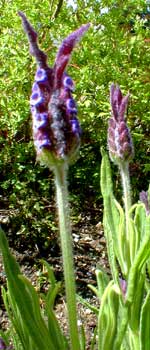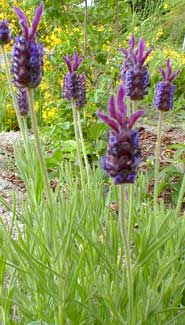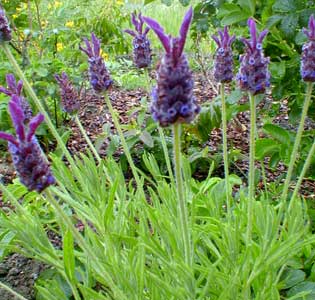 'Helmsdale' Spanish Lavender; aka,
'Helmsdale' Spanish Lavender; aka,
'Hemsdale Genghel' French Lavender
'Helmsdale' is a particularly robust hybrid lavender. This cultivar started with Lavendula stoechas pedunculata, the Spanish or Papillon Lavender, native to Spain & southern France. It was hybridized with the only half-hardy green-flowering L. viridis, a native of southwest Spain & southern Portugal.
 It was developed at Marshwood Gardens in New Zealand to withstand cooler climates. It is said to survive down to zone 5, when zone 7 is iffy for some varieties.
It was developed at Marshwood Gardens in New Zealand to withstand cooler climates. It is said to survive down to zone 5, when zone 7 is iffy for some varieties.I have my doubts about such extreme cold tolerances as I've seen field studies that did not praise its hardiness quite as highly as vendors do. But that doesn't matter for our gardens, where it will never have its hardiness at such cold temperatures tested. We're zone 8, which is ideal for the species, though our rainfall can be a bit much for it at times & it requires extremely well-draining ground in fullest sun.
It grows into a substantial bushy subshrub, thirty by thirty inches, & produces flowers like crazy starting mid or late spring, lasting clear through summer & into early autumn. If flowers seem about to quit at any time in summer, a sheering just of the spent flower spikes should induce rebloom.
It may become woody after a few years & might begin to lose its beauty, at which time it would need to be replaced with youngsters started from cuttings in covered frames or in pots.
 To start a new plant, take summer cuttings of half-ripe wood at heel & touch the heel to a bit of rooting hormone. In a covered frame, the majority of cuttings will root themselves. Protect the young plants from harsh temperatures until spring, when they can be put into their permanent locations.
To start a new plant, take summer cuttings of half-ripe wood at heel & touch the heel to a bit of rooting hormone. In a covered frame, the majority of cuttings will root themselves. Protect the young plants from harsh temperatures until spring, when they can be put into their permanent locations.The flowers of 'Helmsdale' are a rich dark navy purple edging toward burgundy, & the large bow-tie or rabbit-ear bracts on top are more nearly burgundy, these ears being a mite thinner than on the plain species. The upright pale green foliage is slender & compact.
Generally it is recommended to sheer Spanish Lavender after it stops blooming, which will be the end of summer or early autumn. But since 'Helmsdale' can be grown in cooler climates, in colder zones it should not be shorn until spring, because an autumn-sheering is too apt to induce new growth that will be damaged by freezing.
In our zone, however, it is sheered at end of its long bloom time, but not too far beneath the spent bloom spikes, as it is worth preserving the majority of the foliage for its evergreen presence throughout winter. If the clump has gotten lanky, more can be sheered late winter or early spring, just before new growth. Once it has developed a woody center, it should not be sheered too close to the wood, or a bare spot may be long in repairing itself.
Our clump of 'Helmsdale' Spanish Lavender grows on a stone ledge on the front edge of a streetside rugosa rose garden, alongside second Spanish lavender cultivar, the dwarf red-flowering L. stoechus 'Chica Rose.'
It likes poor soil without a lot of organic matter, & very little water. In richer soil it produces more leaves, but becomes floppier & with less redolence. It stands up well to harsh winds as well as droughtiness, but if the ground drains poorly it will die during rainy seasons.